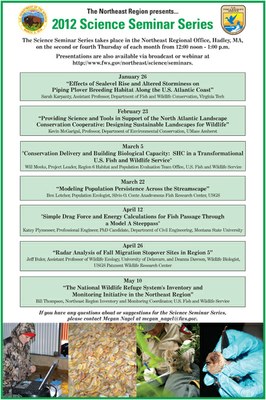US Fish and Wildlife Service - Science Seminar Series - Patch Metrics, Wild Brook Trout, and the Chesapeake Bay - March 8 - National LCC Event
| When |
Mar 08, 2012
from 12:00 PM US/Eastern to 01:00 PM US/Eastern |
|---|---|
| Where | Northeast Region Office Large Auditorium/ Online |
| Attendees |
Mark Hudy |
| Add event to calendar |
|

The wild brook trout resource in the Chesapeake Bay has been significantly reduced over the last 150 years and faces ongoing and future threats from climate change, land use changes, invasive species and loss of genetic integrity (Hudy et al. 2008). Monitoring both short and long term trends on individual brook trout (Salvelinus fontinalis) populations and the resource as a whole are important needs of managers. Past assessments on the 1,443 subwatersheds in the Chesapeake Bay found that 226 had healthy brook trout (intact); 542 had reduced populations and 290 were extirpated (Hudy et al. 2008). However, the subwatershed scale assessment was not fine scale enough to efficiently monitor trends on the ground of interest to many mangers. Standard population estimates using mark-recapture and depletion removal estimates are also not viable for large scale monitoring because of expense, inability to detect trend (i.e. large coefficient in variation), and problems expanding the sample to the entire population. However, fine scale occupancy data (at the catchment level) exist for the majority of the brook trout resource in the Chesapeake Bay. Currently (not counting New York, not completed yet), there are 3,003 catchments containing allopatric brook trout populations; 1,716 catchments containing sympatric populations (with brown or rainbow trout); and 1,966 catchments containing only exotic trout species. We used this fine scale catchment data to identify unique patches of brook trout. We define a "patch" as a group of contiguous catchments occupied by wild brook trout. Patches are not connected physically (separated by a dam, unoccupied warm water habitat, downstream invasive species, etc) and are generally assumed to be genetically isolated. In the Chesapeake Bay there are 868 patches of brook trout habitat with an average patch size of 2,800 ha.























